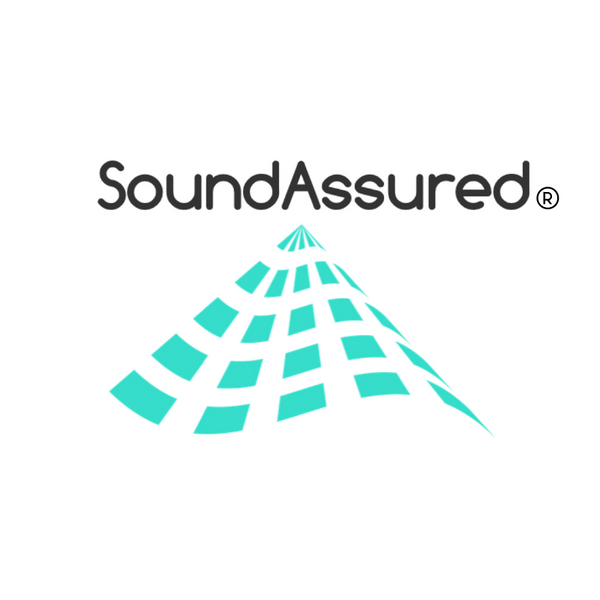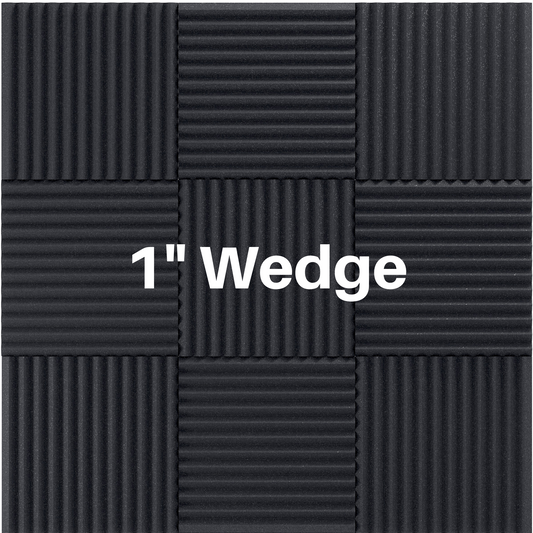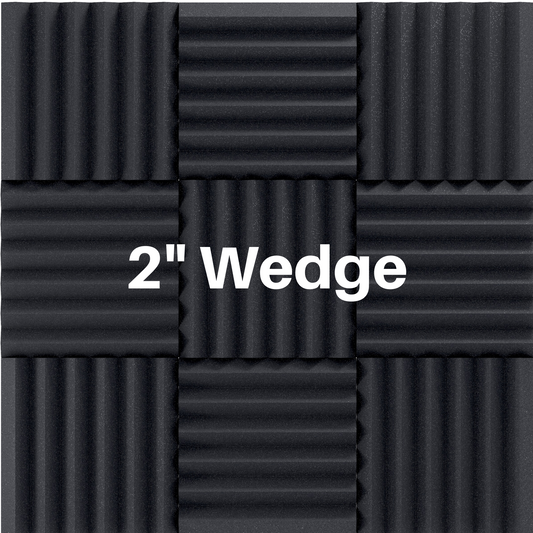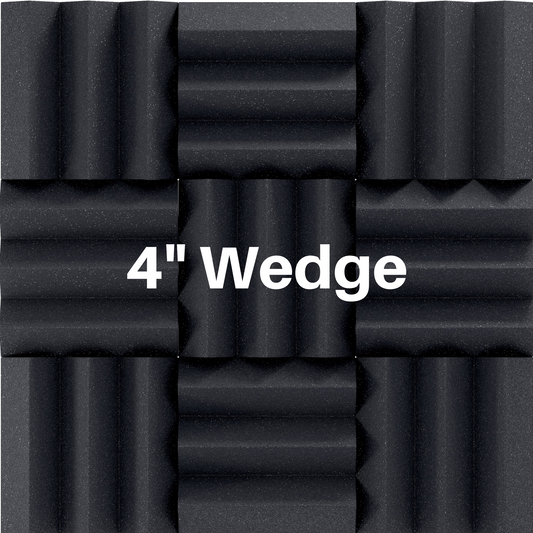How to Install Acoustic Panels for Maximum Effectiveness
Share
Note that some of the product recommendations in this article are external links, as we want to provide you with the best solutions possible.
Understanding How Acoustic Panels Work
Acoustic panels absorb sound waves which prevents them from bouncing around the room. This improves sound clarity and reduces echo, making your space more comfortable for recording, speaking, or just relaxing.

Identify Reflection Points
Before installing, find the key reflection points where sound bounces the most. These spots are where your panels will be most effective.
Tip to Find Reflection Points
If you have a 2 Channel setup (two speakers in the room) a good way to find the reflection point is using the mirror trick.
The Mirror Trick:
- Sit in your main listening position.
- Have a friend move a small mirror along the walls.
- When you see the speakers or sound source in the mirror, mark that spot with tape—that’s a key reflection point!
Reflection points vary depending on how a room is used because different spaces have different sound sources and acoustic challenges. Below we outline the tips and tricks for different types of rooms.
Recording Studio Control Room
🔹 Main Sound Sources: Studio monitors
🔹 Typical Reflection Points:
- Side walls (first reflection points) – Sound from monitors bounces off the walls and causes phase issues.
- Behind the monitors (front wall) – Can create comb filtering and phase cancellation.
- Ceiling (above mixing position) – Causes vertical reflections that interfere with stereo imaging.
- Back wall – Can cause strong bass reflections, muddying the mix.
✅ Treatment Strategy:
- Absorption panels at first reflection points for clarity.
- Thick bass traps in corners to manage low-end buildup.
- Diffusers on the back wall to maintain a balanced sound.
- Ceiling cloud above mix position to control vertical reflections.
The image below shows an installation plan for one of our customers' home recording studios.

Vocal Booth
🔹 Main Sound Source: Voice (static, usually facing a microphone)
🔹 Typical Reflection Points:
- Front wall behind the mic – Sound bounces off the wall behind the microphone and comes back into the recording.
- Side walls – Reflections from the singer’s voice hit the side walls and return to the mic.
- Ceiling – Sound from the voice can reflect downward, creating comb filtering.
- Floor (if untreated) – Can cause subtle reflections if not carpeted.
✅ Treatment Strategy:
- Thick absorption (4”) behind the mic to prevent reflections bouncing back into the recording.
- Absorption on side walls and ceiling to minimize flutter echo.
- Carpet or thick rug to absorb floor reflections.
- Bass traps in the corners to prevent room modes and distortion.
Genie Mixed It's vocal booth shown below treated with our pro acoustic foam.


Jam Room / Band Rehearsal Space
🔹 Main Sound Sources: Drums, guitars, vocals, bass (multiple, often moving)
🔹 Typical Reflection Points:
- Behind the drum set – Cymbals and snare create sharp reflections off walls and ceiling.
- Side walls near guitar amps – Guitar sound waves bounce off nearby walls.
- Corners – Bass builds up in corners, creating an uneven low-end.
- Ceiling above drum set – Overhead reflections contribute to an overly boomy room.
✅ Treatment Strategy:
- Absorption behind and above the drum kit to prevent sharp reflections.
- Bass traps in corners to control low-end buildup.
- Panels on walls at ear height where instruments project the most sound.
- Diffusers on the back wall to keep the room lively without excessive reflections.

Home Theater
🔹 Main Sound Sources: TV speakers, soundbars, surround sound, possible 2 channel setup with subwoofer
🔹 Typical Reflection Points:
- Side walls at ear level – Reflections from front speakers bounce directly to the listening position.
- Ceiling (if untreated) – Creates an echoey, boomy sound.
- Back wall – Can cause excessive reflections that muddy the audio experience.
✅ Treatment Strategy:
- Absorption at first reflection points (side walls and ceiling).
- Bass traps in corners if the subwoofer is producing muddy bass.
- Diffusers on the back wall if the room sounds too “dead” after treatment.

Gym / Fitness Room
🔹 Main Sound Sources: Loudspeakers, music playback, voices, equipment noise
🔹 Typical Reflection Points:
- Large empty walls – Can cause echo and harsh reverb.
- Ceiling (especially high ceilings) – Sound bounces, making speech unintelligible.
- Glass or mirrors – Strong reflections that amplify noise.
✅ Treatment Strategy:
- Acoustic panels on walls and ceiling to reduce echo.
- Thick rubber flooring to absorb impact noise.
- Baffles or hanging panels for gyms with high ceilings.
Shown below is LJ's fitness in PA that used our hexagon acoustic panels to dampen sound in their fitness studio.

Office / Conference Room
🔹 Main Sound Sources: People talking, conference calls, background noise
🔹 Typical Reflection Points:
- Walls near seating areas – Can cause speech to bounce and become muddy.
- Glass walls or windows – Can create sharp, harsh reflections.
- Ceiling – If untreated, speech clarity decreases due to echoes.
✅ Treatment Strategy:
- Absorption panels on walls near speaking positions.
- Ceiling panels or clouds to reduce speech echo.
- Acoustic dividers if multiple conversations are happening.
Below shows ceiling baffles used to damp and sound in a commercial office space.

What If There Are No Clear Reflection Points or Multiple Sound Sources?
Sometimes, a room may not have obvious reflection points, or sound sources may move around.
Evenly Distribute Absorption Panels
Instead of targeting specific points, spread panels evenly around the room. Use a mix of broadband absorbers (2”-4” thick) to cover a wide frequency range. The panels can be evenly distributed around the room on the walls and ceilings in a way that makes the room look nice.
For the best results, do not place all your panels next to each other like tiles.
✅ Space them evenly around the room.
✅ Keep some distance between each panel to allow for even sound absorption.
Use Diffusion Too Avoid An Overly Deadened Room
If a room starts to sound too “dead,” add diffusers to maintain a natural balance.
Other Ideas For Sound Absorption In Rooms
Furniture Placement – Upholstered couches, chairs, and bookshelves filled with books can help absorb and diffuse sound.
Rugs & Carpeting – Thick area rugs or wall-to-wall carpeting reduce sound reflection from hard floors.
Heavy Curtains & Drapes – Thick, multi-layered curtains (especially blackout curtains) help absorb sound from windows and walls.
Tapestries & Fabric Wall Hangings – Hanging fabric panels or tapestries can act as makeshift absorbers.
Houseplants – Large leafy plants help break up sound waves and reduce echoes in a room.
Mounting Your Acoustic Panels
Installing your acoustic panels depend on the type of panel you choose.
Check out This Page with instructions and videos on how to install all of our professional acoustic treatments. Please reach out with any questions.




